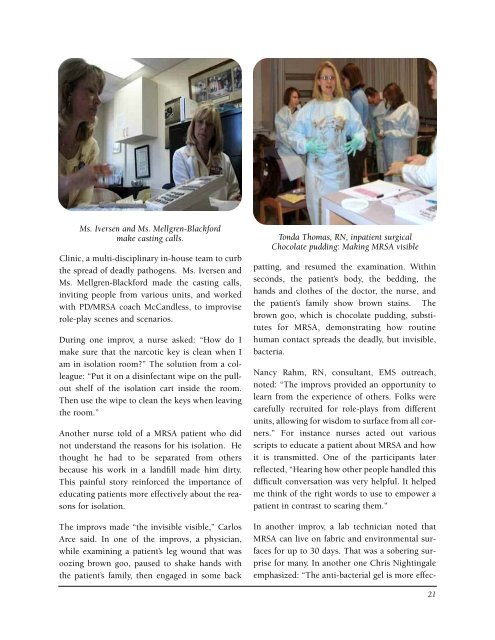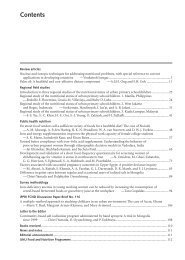From Invisible to Visible - Positive Deviance Initiative
From Invisible to Visible - Positive Deviance Initiative
From Invisible to Visible - Positive Deviance Initiative
You also want an ePaper? Increase the reach of your titles
YUMPU automatically turns print PDFs into web optimized ePapers that Google loves.
Ms. Iversen and Ms. Mellgren-Blackford<br />
make casting calls.<br />
Clinic, a multi-disciplinary in-house team <strong>to</strong> curb<br />
the spread of deadly pathogens. Ms. Iversen and<br />
Ms. Mellgren-Blackford made the casting calls,<br />
inviting people from various units, and worked<br />
with PD/MRSA coach McCandless, <strong>to</strong> improvise<br />
role-play scenes and scenarios.<br />
During one improv, a nurse asked: “How do I<br />
make sure that the narcotic key is clean when I<br />
am in isolation room?” The solution from a colleague:<br />
“Put it on a disinfectant wipe on the pullout<br />
shelf of the isolation cart inside the room.<br />
Then use the wipe <strong>to</strong> clean the keys when leaving<br />
the room.”<br />
Another nurse <strong>to</strong>ld of a MRSA patient who did<br />
not understand the reasons for his isolation. He<br />
thought he had <strong>to</strong> be separated from others<br />
because his work in a landfill made him dirty.<br />
This painful s<strong>to</strong>ry reinforced the importance of<br />
educating patients more effectively about the reasons<br />
for isolation.<br />
The improvs made “the invisible visible,” Carlos<br />
Arce said. In one of the improvs, a physician,<br />
while examining a patient’s leg wound that was<br />
oozing brown goo, paused <strong>to</strong> shake hands with<br />
the patient’s family, then engaged in some back<br />
Tonda Thomas, RN, inpatient surgical<br />
Chocolate pudding: Making MRSA visible<br />
patting, and resumed the examination. Within<br />
seconds, the patient’s body, the bedding, the<br />
hands and clothes of the doc<strong>to</strong>r, the nurse, and<br />
the patient’s family show brown stains. The<br />
brown goo, which is chocolate pudding, substitutes<br />
for MRSA, demonstrating how routine<br />
human contact spreads the deadly, but invisible,<br />
bacteria.<br />
Nancy Rahm, RN, consultant, EMS outreach,<br />
noted: “The improvs provided an opportunity <strong>to</strong><br />
learn from the experience of others. Folks were<br />
carefully recruited for role-plays from different<br />
units, allowing for wisdom <strong>to</strong> surface from all corners.”<br />
For instance nurses acted out various<br />
scripts <strong>to</strong> educate a patient about MRSA and how<br />
it is transmitted. One of the participants later<br />
reflected, “Hearing how other people handled this<br />
difficult conversation was very helpful. It helped<br />
me think of the right words <strong>to</strong> use <strong>to</strong> empower a<br />
patient in contrast <strong>to</strong> scaring them.”<br />
In another improv, a lab technician noted that<br />
MRSA can live on fabric and environmental surfaces<br />
for up <strong>to</strong> 30 days. That was a sobering surprise<br />
for many. In another one Chris Nightingale<br />
emphasized: “The anti-bacterial gel is more effec-<br />
21

















